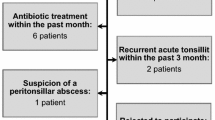Abstract
A polymicrobial mixture of aerobic and anaerobic bacteria is commonly recovered from peritonsillar abscess (PTA) aspirates. Previous studies have suggested a role for Fusobacterium necrophorum (FN) in the development of PTA. The purpose of the current study was to explore whether anti-FN antibodies were produced in patients with PTA. We developed a novel immunofluorescence-based method to measure anti-FN antibody levels in acute and convalescent sera from 15 patients with PTA and 47 patients with chronic tonsillar conditions (controls) undergoing acute or elective tonsillectomy, respectively. Bacterial cultures were performed on tonsillar cores and surfaces, pus aspirates, and blood. An increase in anti-FN antibody levels (of at least doubling of the previous level) was observed in 8 of 11 (73 %) PTA patients with FN-positive pus aspirate cultures (FN-positive patients). In contrast, the four FN-negative PTA patients did not have an increase in anti-FN antibody levels (p = 0.026). The change in anti-FN antibody levels in FN-positive PTA patients was also significantly greater than that for FN-positive electively tonsillectomized patients (p = 0.0014) and all electively tonsillectomized patients (p < 0.001). Our results validate FN as a significant and prevalent pathogen in PTA. This finding has implications for the diagnostic work-up of PTA and may also have implications for the treatment of acute tonsillitis.
Similar content being viewed by others
References
Brook I (1981) Aerobic and anaerobic bacteriology of peritonsillar abscess in children. Acta Paediatr Scand 70:831–835
Jousimies-Somer H, Savolainen S, Mäkitie A, Ylikoski J (1993) Bacteriologic findings in peritonsillar abscesses in young adults. Clin Infect Dis 16(Suppl 4):S292–S298
Fine AM, Nizet V, Mandl KD (2012) Large-scale validation of the Centor and McIsaac scores to predict group A streptococcal pharyngitis. Arch Intern Med 172:847–852. doi:10.1001/archinternmed.2012.950
Centor RM, Witherspoon JM, Dalton HP, Brody CE, Link K (1981) The diagnosis of strep throat in adults in the emergency room. Med Decis Making 1:239–246
Jokipii AM, Jokipii L, Sipilä P, Jokinen K (1988) Semiquantitative culture results and pathogenic significance of obligate anaerobes in peritonsillar abscesses. J Clin Microbiol 26:957–961
Ehlers Klug T, Rusan M, Fuursted K, Ovesen T (2009) Fusobacterium necrophorum: most prevalent pathogen in peritonsillar abscess in Denmark. Clin Infect Dis 49:1467–1472
Flodström A, Hallander HO (1976) Microbiological aspects on peritonsillar abscesses. Scand J Infect Dis 8:157–160
Aasted B, Bernstein D, Klapper DG, El Kholy A, Krause RM (1979) Detection of antibodies in human sera to streptococcal groups A and C carbohydrates by a radioimmunoassay. Scand J Immunol 9:61–67
Hagelskjaer Kristensen L, Prag J (2008) Lemierre’s syndrome and other disseminated Fusobacterium necrophorum infections in Denmark: a prospective epidemiological and clinical survey. Eur J Clin Microbiol Infect Dis 27:779–789
Hagelskjaer Kristensen L, Prag J (2008) Localised Fusobacterium necrophorum infections: a prospective laboratory-based Danish study. Eur J Clin Microbiol Infect Dis 27:733–739
Klug TE, Henriksen JJ, Fuursted K, Ovesen T (2011) Significant pathogens in peritonsillar abscesses. Eur J Clin Microbiol Infect Dis 30:619–627. doi:10.1007/s10096-010-1130-9
Jensen A, Hagelskjaer Kristensen L, Prag J (2007) Detection of Fusobacterium necrophorum subsp. funduliforme in tonsillitis in young adults by real-time PCR. Clin Microbiol Infect 13:695–701
Ludlam H, Howard J, Kingston B et al (2009) Epidemiology of pharyngeal carriage of Fusobacterium necrophorum. J Med Microbiol 58:1264–1265
Klug TE, Henriksen JJ, Rusan M, Fuursted K, Ovesen T (2012) Bacteremia during quinsy and elective tonsillectomy: an evaluation of antibiotic prophylaxis recommendations for patients undergoing tonsillectomy. J Cardiovasc Pharmacol Ther 17:298–302. doi:10.1177/1074248411423023
Brook I, Foote PA Jr, Slots J (1996) Immune response to anaerobic bacteria in patients with peritonsillar cellulitis and abscess. Acta Otolaryngol 116:888–891
Haffajee AD, Socransky SS (1994) Microbial etiological agents of destructive periodontal diseases. Periodontol 2000 5:78–111
Brook I, Foote PA Jr (1990) Microbiology of “normal” tonsils. Ann Otol Rhinol Laryngol 99:980–983
Stjernquist-Desatnik A, Holst E (1999) Tonsillar microbial flora: comparison of recurrent tonsillitis and normal tonsils. Acta Otolaryngol 119:102–106
Tan ZL, Nagaraja TG, Chengappa MM (1996) Fusobacterium necrophorum infections: virulence factors, pathogenic mechanism and control measures. Vet Res Commun 20:113–140
Kanoe M, Hirabayashi T, Matsuoka Y et al (1996) Use of enzyme-linked-immunosorbent assay for detection of IgG and IgM antibodies to Fusobacterium necrophorum in cattle. Microbios 87:257–262
Batty A, Wren MW (2005) Prevalence of Fusobacterium necrophorum and other upper respiratory tract pathogens isolated from throat swabs. Br J Biomed Sci 62:66–70
Fourage M, Bourguignat C, Fermond B, Delobel P (2013) A recurrent tonsillitis. Lancet 381:266. doi:10.1016/S0140-6736(12)61606-7
Centor RM, Geiger P, Waites KB (2010) Fusobacterium necrophorum bacteremic tonsillitis: 2 cases and a review of the literature. Anaerobe 16:626–628. doi:10.1016/j.anaerobe.2010.08.005
Centor RM (2009) Expand the pharyngitis paradigm for adolescents and young adults. Ann Intern Med 151:812–815. doi:10.7326/0003-4819-151-11-200912010-00011
Bank S, Christensen K, Kristensen LH, Prag J (2013) A cost-effectiveness analysis of identifying Fusobacterium necrophorum in throat swabs followed by antibiotic treatment to reduce the incidence of Lemierre’s syndrome and peritonsillar abscesses. Eur J Clin Microbiol Infect Dis 32:71–78. doi:10.1007/s10096-012-1715-6
Aliyu SH, Marriott RK, Curran MD et al (2004) Real-time PCR investigation into the importance of Fusobacterium necrophorum as a cause of acute pharyngitis in general practice. J Med Microbiol 53:1029–1035
Amess JA, O’Neill W, Giollariabhaigh CN, Dytrych JK (2007) A six-month audit of the isolation of Fusobacterium necrophorum from patients with sore throat in a district general hospital. Br J Biomed Sci 64:63–65
Price SL, Hardy S, Gale P, Basten GP (2011) Prevalence of Fusobacterium necrophorum in persistent sore throat samples. Br J Biomed Sci 68:209–210
Acknowledgments
The authors wish to acknowledge the Skouby Foundation and the Poul Traun-Petersens Memorial Grant for financial support.
Conflict of interest
The authors declare that we have no conflict of interest.
Author information
Authors and Affiliations
Corresponding author
Rights and permissions
About this article
Cite this article
Klug, T.E., Henriksen, JJ., Rusan, M. et al. Antibody development to Fusobacterium necrophorum in patients with peritonsillar abscess. Eur J Clin Microbiol Infect Dis 33, 1733–1739 (2014). https://doi.org/10.1007/s10096-014-2130-y
Received:
Accepted:
Published:
Issue Date:
DOI: https://doi.org/10.1007/s10096-014-2130-y




